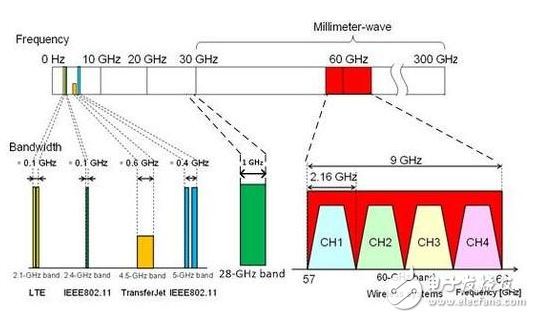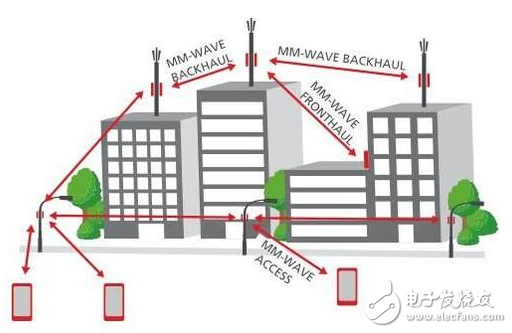The deadline for official commercialization of 5G in 2020 is getting closer. At present, major manufacturers are accelerating their testing on 5G technology. I remember that last week, Huawei and Vodafone completed a 5G millimeter wave outdoor field test to achieve a peak transmission speed of 20Git/s for single-user devices. However, as expected, the final 5G transmission rate will be 1Gb/s, which is more than ten times faster than 4G. How to achieve it?
1, the key to getting 5G faster than 4G 10 times
What is a millimeter wave? Will this be the key to 5G's high-speed transmission? In fact, the millimeter wave refers to an electromagnetic wave having a wavelength of 1 to 10 mm, and its frequency is approximately between 30 GHz and 300 GHz. It is located in the wavelength range where the microwave and the far infrared wave overlap, and thus has the characteristics of both pops. In theory, millimeter waves are the development of light waves to low frequencies and the extension of microwaves to high frequencies.

From the communication principle, the maximum signal bandwidth of wireless communication is about 5% of the carrier frequency. That is to say, the higher the carrier frequency, the larger the achievable signal bandwidth. In addition, in the millimeter wave band, 28 GHz and 60 GHz are the two bands most promising for 5G communication. Among them, the available spectrum bandwidth of 28GHz can reach 1GHz, and the available signal bandwidth of each channel of 60GHz can reach 2GHz.
Compared with 5G communication, the highest frequency band of 4G-LTE is about 2GHz, so its available spectrum bandwidth is only 100MHz. With the millimeter wave band, the spectrum bandwidth can be turned 10 times and the transmission rate will be faster. Therefore, 5G will not only mean 10 seconds to transmit a 1GB movie, it will also support more applications such as cloud games, virtual reality and more.
2, valuable frequency band resources
It is well known that wireless communication relies on electromagnetic wave propagation, and the most precious resource is the frequency band. Currently, telecom operators have begun to study millimeter-wave technology to find the most suitable frequency range for mobile applications. In order to unify the global millimeter-wave frequency standard, the International Telecommunication Union (ITU) announced the proposed list of globally available frequencies between 24 GHz and 86 GHz after the recent World Radiocommunication Conference. Finally, the three bands of 28 GHz, 39 GHz and 73 GHz gradually stand out.
Based on the availability of 28GHz in the United States, South Korea and Japan, coupled with the early field testing of US telecommunications operators, the spectrum, whether or not it becomes an international standard, may directly become a mobile technology application in the United States. In addition, South Korea's goal of demonstrating 5G technology in the 2018 Olympics may also be the first to promote 28GHz technology for consumer products before the standards organization determines the 5G standard. Although it is still not possible to confirm whether 28 GHz can be widely used in 5G applications, this frequency is absolutely very important at this stage.
At the same time as the 28GHz related research, the E-band frequency has also attracted attention in the field of mobile communication in recent years. In the opening paragraph, Huawei and Vodafone are conducting outdoor field tests on 5G on the E-Band microwave. In addition, one of the characteristics distinguishing the relationship between 73 GHz and 28 GHz and 39 GHz is the available continuous bandwidth.
A continuous bandwidth of 2 GHz in the 73 GHz is available for mobile communications, which is the most extensive of the proposed frequency spectrum; 28 GHz provides only 850 MHz of bandwidth; in the United States, there are two bands around the 39 GHz that provide 1.6 GHz and 1.4 GHz bandwidth. In addition, according to Shannon's law, that is, higher bandwidth represents a higher amount of data transmission, 73 GHz is more advantageous than the other two frequencies.
3, the characteristics of millimeter waves
Having said that, what are the characteristics of millimeter waves? In theory, millimeter waves are the development of light waves to low frequencies and the extension of microwaves to high frequencies. Due to the unique characteristics of millimeter waves, it is not easily affected by natural light and heat radiation sources during propagation, not only for communication, but also for radar, guidance and many other fields.
For example, using the millimeter-wave frequency of the atmospheric window, large-capacity satellite-to-ground communication can be realized, and high-resolution millimeter-wave radiometers can be used to remotely sense meteorological parameters. Radio astronomical telescopes can also be used to detect the radiation spectrum of space, thereby inferring interstellar matter. ingredient. Millimeter wave technology has also generated tremendous power for the transmission of network signals.
For users, wireless broadband using millimeter-wave technology is much faster than broadband speeds from cable companies or telephone companies. Although there are Internet technologies such as WIFI and LIFI, the millimeter wave technology that transmits signals through air is undoubtedly another good alternative.
4, the key to 5G communication
Of course, things have two sides, as do millimeter waves. Although millimeter wave technology is widely used, it also inevitably has short plates. For example, its propagation distance can only be at most 200 meters, it can not achieve long-distance transmission, or the millimeter wave penetration ability is not strong, the attenuation in the air is large, and it can not function if it encounters a wall or other obstacles.
However, the large attenuation of millimeter waves in the air can also be used for us. As long as you want to improve the transmission distance of millimeter waves, for cost reasons, the larger the distance, the fewer network base stations need to be built, and the more cost savings. Therefore, in terms of network technology transmission, the millimeter wave can not be used alone, and it needs to be combined with other technologies to form a superimposed network to realize the transmission function of the network signal.

If the millimeter-wave small base station can be used, it is advantageous to solve the problem that the macro base station and the small base station switch frequently, resulting in poor user experience. The macro base station can operate in the low frequency band as the control plane of the mobile communication, and the millimeter wave small base station can work as the user data plane of the mobile communication in the high frequency band, and the two cooperate to complement each other.

In addition, using the millimeter wave channel as the mobile communication backhaul, the new small base station can be deployed at any time according to the actual situation of the data traffic, and the small base station can be turned off during the idle or light traffic period. Flexible deployment also reduces energy consumption and saves resources. Another feature of millimeter waves is that the physical size of the antenna can be smaller because the physical size of the antenna is proportional to the wavelength of the band, so hardware manufacturers can more easily equip the mobile device with a millimeter-wave antenna array to achieve various MIMO. technology.
Although at present, we still don't know how 5G technology will develop in the future, but we can be sure that millimeter wave will become a key technology in the development of 5G network because of its unique advantages. Although the millimeter wave has defects in transmission distance and penetration, its application prospect is extremely broad. Next, just determine which millimeter-wave band to use for mobile communications.
Some client may feel that 10th Laptop is little old, so prefer 11th Laptop or 12th laptop. However, you will the 10th cpu is even more powerful than 11th, but price is nearly no difference, especially you take in lot, like 1000pcs. As a professional manufacturing store, you can see Laptop i3 10th generation 8gb ram,i5 laptop 10th generation, intel i7 10th gen laptop, etc. It`s a really tough job selecting a right one on the too many choices. Here are some tips, hope help you do that easier. Firstly, ask yourself what jobs you mainly need this Gaming Laptop to do. Secondly, what special features you care more? Like fingerprint, backlight keyboard, webcam rj45, bigger battery, large screen, video graphics, etc. Finally, ask the budget you plan to buy gaming laptop. Thus you will get the idea which laptop is right one for you.
Except integrated laptop, also have graphic laptop with 2gb or 4gb video graphic, so you can feel freely to contact us anytime and share your basic requirements, like size, cpu, ram, rom, video graphics, quantity,etc. More detailed value information provided in 1-2 working days for you.
10th Laptop,Laptop I3 10th Generation 8gb Ram,I5 Laptop 10th Generation,10th Generation Laptop,Intel I7 10th Gen Laptop
Henan Shuyi Electronics Co., Ltd. , https://www.shuyiminipc.com